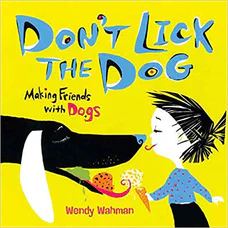Don’t Lick the Dog
Making Friends with Dogs
Written and illustrated by Wendy Wahman
32 pages
•
Published 2009 (Henry Holt and Co.)

Recommended Age Range: Preschool through 2nd grade.
Publisher's Summary:
Meeting a new dog is exciting, but it can also be scary. This humorous how-to manual shows kids the best ways to interact with unfamiliar dogs, providing helpful tips about all sorts of dog behavior. Children often don’t understand what dogs’ actions mean and can misinterpret a threatening signal for a friendly one and vice versa. Kids and parents will return to Wendy Wahman’s playful illustrations again and again for useful reminders: Slow Down. Stay very still. And remember, don’t lick the dog!

Dr. Annie's Takeaways
Recommended for: This book is a great read for children who do not feel confident in their ability to interact safely with dogs. It teaches kids how dogs like to be approached and what to do if a dog is feeling threatened or scared in order to prevent unsafe interactions. This book might be extra useful for kids to read with caregivers who are also a little wary of dogs.
Would a child like it? For a doggy instruction manual, it’s a pretty fun read. The pictures are great, and many children may be relieved to hear that most dogs are really quite predictable!
Evidence-Based Practices:
Psychoeducation
Tone: Silly, playful
Story Quality: This story is essentially a list of specific instructions for interacting safely with dogs (e.g., “Stand still and let dogs come to you to smell your hand or sniff your shoe”), but it’s written in a fun rhyming verse that makes it enjoyable to read.
Illustrations: I really like the illustrations. They are bold and colorful with a bit of edge.
Representation: There are three children featured in the book–two girls and a boy. They all have straight black hair, and are pictured with different colored skin in different pictures (literally white, yellow, blue, beige). There is a woman who teaches the children about dogs. She has white skin and black hair.
Psychological Practices: This book teaches children how to interact with dogs safely (e.g., “Bootsy wants to run away and hide when packs of noisy kids arrive. Turn away, pretend you’re shy. She’ll come to you; just give her time”), when it is potentially unsafe (e.g., “When Maddie makes that awful sound and wears that ugly wrinkled frown”), and what they can do to stay safe (“Stand up straight, stay very still. If you let her walk away, she will”). I appreciate that this book acknowledges that dogs can be dangerous if a child doesn’t interact with them properly. For a child with a fear of dogs, this book validates this and teaches children that there are ways they can interact with a dog to significantly increase their safety.
Concerns: None
